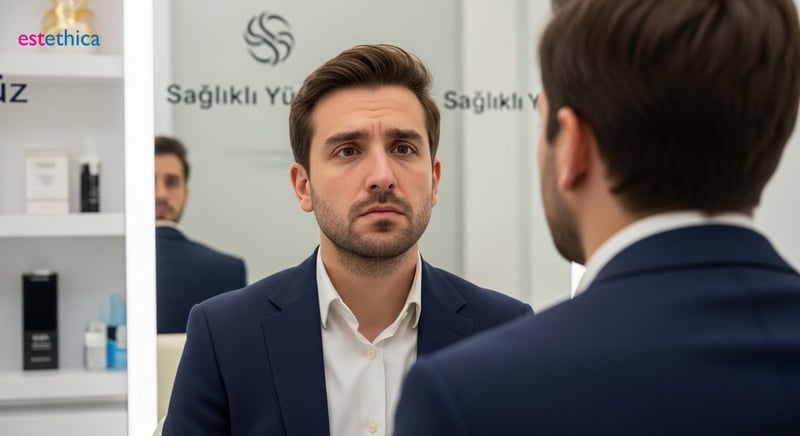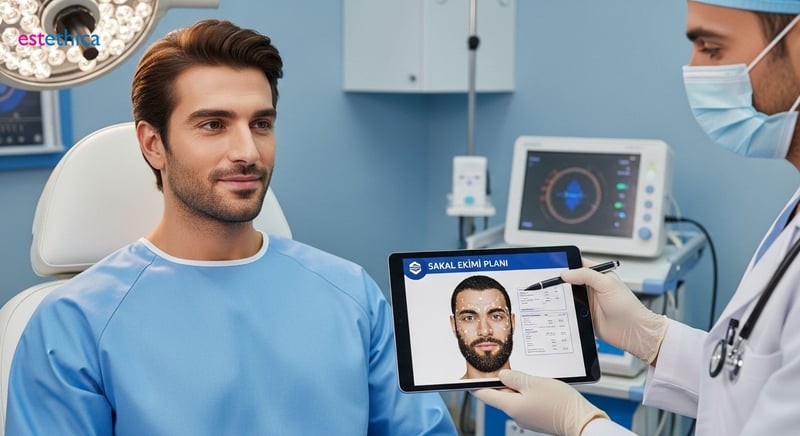Beard Transplant: Guide to Fuller Facial Hair Density
A comprehensive overview of beard transplant procedures, focusing on techniques for improving beard density, the transplantation process, and expected results for natural-looking facial hair restoration.
What is a Beard Transplant? Understanding the Basics
For individuals seeking to enhance their facial hair, a beard transplant offers a sophisticated and permanent solution. At its core, this surgical procedure is designed to restore or significantly improve beard density and overall appearance. It works by meticulously transplanting individual hair follicles from a donor area, most commonly the back or sides of the scalp where hair is typically robust and less susceptible to thinning, to areas of the face exhibiting sparse or absent beard growth.
This advanced technique mirrors the principles used in scalp hair transplantation, providing a reliable method for achieving a fuller, more defined beard. The primary objective of a beard transplant is to create a natural-looking result that harmonizes seamlessly with your existing facial hair, enhancing your overall aesthetic. Understanding the fundamentals of this procedure is the crucial first step for anyone considering its potential benefits for their facial grooming and appearance.
The Science Behind Facial Hair Enhancement
The process involves carefully extracting follicular units from the donor site. These units contain one or more hair follicles. Using specialized instruments, these follicles are then implanted into tiny incisions made in the recipient areas of the face, such as the cheeks, chin, or mustache region. The placement is strategic, considering the natural growth direction and density of existing facial hair to ensure a lifelike outcome. The transplanted follicles, once settled, will begin to grow new beard hairs that are permanent and indistinguishable from your natural beard. This makes it an effective option for those wondering how to improve beard density naturally and permanently.
Benefits and Expectations
The advantages of undergoing this procedure extend beyond simply increasing hair count. It can dramatically improve the uniformity and aesthetic appeal of your beard, addressing patchiness and creating a more masculine and confident look. For men who have experienced hair loss in their beard area due to genetics, scarring, or medical conditions, this procedure offers a viable path to regaining a full beard. It's a transformative journey for many, helping them achieve the facial hair they desire. Exploring the beard transplant process and results can provide valuable insights into what to expect and how this solution addresses concerns about patchy beards. For those curious about the overall journey, learning more about the Beard Transplant: Achieve Fuller, Natural Facial Hair can offer comprehensive details.
The ability to permanently enhance facial hair makes a beard transplant a compelling choice for many. It’s not just about adding hair; it’s about restoring confidence and achieving a desired look through a safe and proven surgical method. The detailed planning and execution ensure that the final result is as natural as possible, addressing the core desire of how to improve beard density effectively. When considering the different avenues available, the long-term efficacy of a beard transplant often stands out, offering a lasting solution to sparse facial hair concerns. Understanding the beard transplant process and results is key to making an informed decision about this cosmetic enhancement, and it’s a crucial part of the journey for anyone asking how to improve beard density.

The Beard Transplant Process: Step-by-Step Guide
Embarking on the journey to enhance your facial hair often leads to exploring options like a beard transplant. Understanding the procedure is key to setting realistic expectations and appreciating the meticulous care involved. The entire beard transplant process is designed to be as comfortable and effective as possible, focusing on natural-looking outcomes.
Initial Consultation and Planning
The process typically begins with a comprehensive consultation. During this crucial first step, your surgeon will assess your current facial hair pattern, analyze the availability of donor hair (usually from the back or sides of your scalp), and discuss your aesthetic goals. This personalized assessment is vital for determining eligibility and crafting a tailored treatment plan. We aim to understand precisely what you envision for your beard, helping us to plan how to improve beard density and shape effectively. This discussion ensures that the final result aligns perfectly with your desires, contributing to the overall success of the beard transplant process and results.
The Procedure: Follicle Extraction and Implantation
Once the plan is finalized, the procedure itself commences. Advanced techniques, most commonly Follicular Unit Extraction (FUE), are employed to harvest individual hair follicles from the donor area. This method is minimally invasive, ensuring that the donor site heals quickly with minimal scarring. Following extraction, these precious follicles are meticulously prepared and then implanted into tiny incisions made in the recipient areas of your face. The surgeon carefully positions each follicle, paying close attention to the angle, direction, and density to mimic natural beard growth patterns. This precision is paramount in achieving a seamless and authentic appearance. For those seeking to understand how to improve beard density, this surgical approach offers a permanent solution.
Recovery and Results
The entire beard transplant is performed under local anesthesia, ensuring your comfort throughout the procedure. Post-procedure, you can expect some minor redness and scabbing in both the donor and recipient areas. These are temporary and typically subside within a week or two as healing progresses. Following the initial recovery phase, the transplanted hairs will shed, which is a normal part of the growth cycle. New, permanent beard growth will begin to emerge within a few months. To learn more about achieving a fuller appearance, consider reading about Beard Transplant: Achieve a Fuller, Natural Look. The commitment to detail throughout the beard transplant process and results ensures that you can achieve the facial hair you desire, effectively answering the question of how to improve beard density naturally and permanently.
Beard Restoration: How to Improve Beard Density Naturally
Achieving a fuller, more defined beard is a common goal for many men. While the term "beard restoration" encompasses various approaches, understanding the options available is crucial. For those wondering how to improve beard density, the journey can involve both natural methods and more direct interventions. Natural approaches focus on optimizing your body's existing capabilities for hair growth. This includes maintaining a balanced diet rich in vitamins and minerals essential for hair health, such as biotin, zinc, and vitamin D. Regular exercise can also contribute by improving blood circulation, which is vital for delivering nutrients to hair follicles. Additionally, a consistent skincare routine that keeps the facial skin clean and moisturized can create an optimal environment for growth.
However, it's important to acknowledge the limitations of natural methods when significant thinning or patchiness is present. While these practices can support healthy hair, they may not be sufficient to drastically increase the number of active follicles. This is where more direct solutions come into play. For individuals seeking a substantial and permanent enhancement in beard thickness, a beard transplant offers a definitive answer. This procedure is specifically designed to address areas of sparseness by transplanting hair follicles from one part of the body to the beard area, directly increasing hair density where it's needed most. The efficacy of a beard transplant in achieving a fuller look makes it a highly sought-after option for complete beard restoration.
Exploring Your Options for Beard Density
When considering how to improve beard density, it's beneficial to compare the different paths one can take. Natural methods are foundational and contribute to overall hair health, but they often require patience and may yield subtle results. Lifestyle adjustments, such as managing stress and ensuring adequate sleep, play a supporting role. Yet, for many, the desire for a visibly thicker beard necessitates a more robust solution. A beard transplant is a surgical procedure that directly implants healthy hair follicles into the desired areas, offering predictable and significant results. Understanding the beard transplant process and results is key to making an informed decision. The journey to a denser beard is multifaceted, with lifestyle playing a crucial part, but for those needing a direct boost, the effectiveness of a beard transplant is undeniable.

Beard Transplant Results: Expectations and Recovery
Understanding the Healing and Growth Phases
The journey following a beard transplant procedure is one of gradual transformation, leading to significant and lasting aesthetic improvements. While the immediate aftermath involves a healing period, the true potential of your enhanced facial hair begins to reveal itself over several months. It's crucial for patients to have realistic expectations regarding the timeline and the natural processes involved. Immediately after the procedure, you might notice some mild swelling and temporary scabbing around the transplanted follicles. This is a completely normal part of the healing process and typically subsides within the first week or two. Your surgeon will provide detailed aftercare instructions, which are vital for ensuring optimal healing and preventing complications.
One common phenomenon patients observe in the initial weeks is the shedding of the transplanted hairs. This is not an indication of failure; rather, it signifies that the hair follicles are settling into their new location and entering a dormant phase. This shedding is a natural precursor to new growth. The transplanted follicles need time to establish a healthy blood supply and begin their new growth cycle. Patience during this phase is key, as it lays the groundwork for the robust and natural-looking beard you desire. Understanding this shedding phase is a fundamental part of comprehending the overall beard transplant process and results.
Witnessing New Growth and Final Outcomes
The most exciting phase of your beard transplant journey begins when new hair starts to emerge. Typically, you can expect to see the initial signs of regrowth within 3 to 4 months post-procedure. These emerging hairs will be fine at first, gradually becoming thicker and more robust over time. This is where the effectiveness of the procedure in addressing concerns about how to improve beard density truly starts to become apparent. As the months progress, the transplanted hairs integrate seamlessly with your existing facial hair, creating a fuller, more defined appearance.
The final, most definitive results of a beard transplant are usually observable between 9 and 12 months after the initial procedure. At this stage, the transplanted grafts have fully settled, and the hair has reached its mature growth phase, offering a permanent enhancement to your facial hair. The goal of the procedure is to achieve a natural look that enhances your facial structure and meets your aesthetic goals. The satisfaction derived from this transformation, understanding the nuances of the beard transplant process and results, often far outweighs the initial recovery period. For those seeking to understand how to improve beard density, this surgical option provides a definitive solution.
Maintaining the health of your new beard involves continued good grooming practices. The transplanted hairs are permanent and will grow like your natural facial hair, requiring regular trimming and styling. The long-term satisfaction with a beard transplant stems from its ability to provide a sustainable and natural-looking solution for thinning or patchy facial hair. This effective method for how to improve beard density results in a significant and permanent boost in confidence for many individuals. The outcome of a successful beard transplant is a fuller, more masculine beard that enhances your overall appearance.

Advanced Techniques for Beard Density Enhancement
The beard transplant procedure utilizes sophisticated techniques, mirroring scalp hair transplantation principles to meticulously transplant individual hair follicles. This process is designed to permanently restore or significantly improve beard density and overall appearance in areas with sparse or absent growth.
Expertise in facial hair restoration focuses on understanding the unique characteristics of beard hair and its growth patterns. This ensures a natural-looking outcome by carefully selecting donor sites and implanting follicles at the correct angle and density.
Specialized knowledge in facial hair transplantation forms the foundation of our beard restoration services. We are dedicated to providing effective beard growth treatments by employing modern beard transplant methods.
Our commitment lies in offering a permanent solution for individuals seeking to enhance their facial hair, guiding them through every step from initial consultation to achieving their desired beard aesthetic.
Transparent Beard Transplant Process and Expected Outcomes
The beard transplant process is a meticulously planned journey, beginning with a comprehensive consultation to understand individual needs and desired outcomes. This ensures a personalized treatment plan is developed for optimal results.
The procedure itself involves carefully extracting follicular units from the donor site and implanting them into the recipient areas of the face. The entire beard transplant is performed under local anesthesia, ensuring comfort and safety throughout the procedure.
Understanding the healing and growth phases is crucial for managing expectations after a beard transplant. Patients can anticipate witnessing new growth that gradually leads to final, satisfying outcomes, thereby improving beard density significantly.
Our focus on patient care and transparent communication builds trust, assuring individuals that their journey to achieve a fuller, more defined beard is in expert hands. We provide the best beard transplant guide to navigate the recovery and results phase.